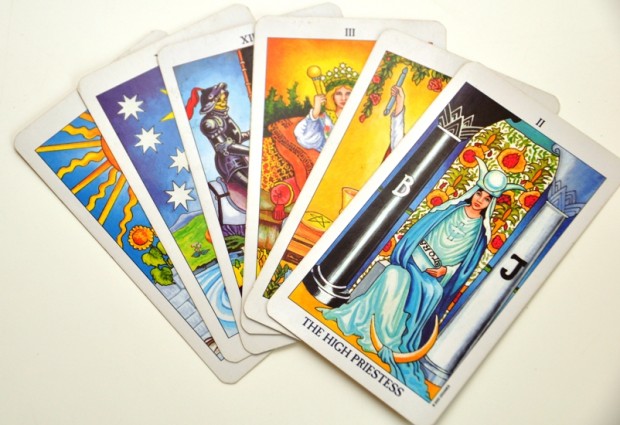
Cassandra Snow takes readers on a queer tour of tarot reading. Check out the first five parts: Queering the Tarot: The Emperor, The Empress, and Archaic Gender Roles, Queering the Tarot: The High Priestess, Queering The Tarot: The Magician, Queering the Tarot, and Queering the Tarot: Let’s Start at the Very Beginning
For most queer tarot card readers, the fifth card in the tarot, the Hierophant, poses a bit of a problem. Traditionally, the Hierophant represents religion, religious leaders, and a conservative orthodoxy that was popular during Catholic reign. As time went on and, at least in the United States, church and state have separated , it has come to represent government and other forms of institutionalization—college, marriage, etc. It can represent an important teacher or leader in one’s life, or it can represent a call to action to become that teacher or leader, but that is still usually backed by a firm, disciplined energy that invokes ideas of government and religious rule. The problem comes with the idea that traditionally this card is seen as a positive one—but for most LGBTQQIA* querants, their experience with the institutions of church and government have not been positive. Many have been rejected by churches, and are still denied equal rights and dignities by the government. Not to mention institutionalized queerphobia being so deeply entrenched in most cultures that we hear “institution” and it’s not a far jump to “systematic oppression” in our minds.
Even so, queering the Hierophant is not necessarily difficult, it just takes delving into the card a little deeper—which I recommend doing at all times regardless. An easy leap to make, especially when you look at the Hierophant as the leader instead of the church or government they are leading is to think of important queer role models in the querant’s life or leaders in the local queer community, and suggest the client look to those people for guidance. Going even deeper, ultimately this card represents the structure of the querant’s current life. Even for the most off the grid radqueer out there, there is some structure that they’ve built that they’ve based their life on. They’ve developed a system of morals and a routine or pattern of behavior based on those. This is the essence of structure, and all persons have that. As this card frequently denotes teaching and leading, the querant could simply be called to show this way to others, or welcome them into their fold. The card could denote they’ve strayed from the structure they’ve built or the morals they adhere too, and it’s time to get back to what has traditionally worked for them—not the traditions of society, but the one’s they’ve developed for survival or success on their own.
Many queer-friendly tarot readers also note that if surrounded by cards that indicate breaking things, healing, or starting over, the hurt and bondage of the traditional Hierophant in our lives could be leaving. Essentially the Hierophant could mean the opposite of it’s traditional meaning—that a break and healing from harmful systematic and institutional oppression is possible. In a negative reading, the Hierophant likely indicates that these bonds of structure and institution are still working against the client, and the next step will be to figure out how to move forward from that. This interpretation is a crucial one, as even with the above explanation of how the Hierophant can mean more than a church, a church leader, or the government, many LGBTQQIA* people will not be able to get past the weight words like institution and tradition have in their lives. It is for these clients and in these cases that we look towards how to break free from the Hierophant, instead of making it’s traditional positivity work for all clients. Just like all interpretations won’t work for all clients, neither will changing the interpretation to match the mood work in every case.

[…] Queering the Tarot: The Hierophant For most queer tarot card readers, the fifth card in the tarot, the Hierophant, poses a bit of a problem. Traditionally, the Hierophant represents religion, religious leaders, and a conservative orthodoxy that was popular during Catholic reign. As time … Read more on TheColu.mn […]
[…] Queering The Tarot: Strength, Queering The Tarot: The Chariot, Queering the Tarot: The Lovers, Queering the Tarot: The Hierophant, Queering the Tarot: The Emperor, The Empress, and Archaic Gender Roles, Queering the Tarot: The […]
Comments are closed.